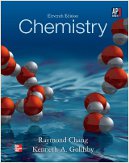
Chemistry, AP* Edition (Chang), 11th EditionWhat's NewNew Author Kenneth Goldsby, Florida State University, has joined Raymond Chang as an author on the eleventh edition of Chemistry. Ken's background in inorganic chemistry has added insight into content and problems, and his extensive work with undergraduate students, both in the classroom and in the laboratory, reinforces Raymond's long tradition of understanding and respecting the student's view of the material as well as the teacher's. New organization with the chapters in the latter part of the text reorganized as follows: Reorganization of these chapters enables those who teach nuclear chemistry to introduce this material right after the coverage of electrochemistry. In addition to recognizing the growing importance of nuclear medicine and the ongoing debate about the role nuclear power will play in addressing future energy needs, the placement of nuclear chemistry before atmospheric chemistry aids the discussion of radon pollution. New is the creation and versatility of our Connect® Chemistry system. McGraw-Hill has initiated a rigorous process to ensure high-quality electronic homework. Through careful observation of real students and active teachers we have been able to evolve the online homework tool to an online learning and engagement tool. The goal of Connect is to usher in a new era of meaningful online learning that balances the conceptual and calculated aspect of this most vital discipline. Each problem within Connect Chemistry carries the text problem-solving methodology and is tailored with specific hints, as well as answer-specific feedback for common incorrect answers. Each question has been accuracy checked by two or more chemistry professors. Several rounds of editorial and chemical accuracy checking, in addition to numerous instructor and student tests of all problems, ensure the accuracy of all content. McGraw-Hill's AP Connect Chemistry features AP Chapter Introductions, AP Chapter Questions, and two complete AP Practice Exams. These resources allow students to practice solving assigned homework problems using the same problem-solving methodology they'll use on the AP Exam. Algorithmic problems serve up multiple versions of similar problems for mastery of content, and hints and feedback for common incorrect answers help students stay on track. McGraw-Hill LearnSmart™, an adaptive diagnostic learning system, powered by Connect Chemistry and based on artificial intelligence, constantly assesses your knowledge of the course material. As you work within the system, LearnSmart develops a personal learning path adapted to what you have actively learned and retained. This innovative study tool also has features to enable your instructor to see exactly what you have accomplished, with a built-in assessment tool for graded assignments. You can access LearnSmart for AP chemistry through McGraw-Hill's AP Connect Chemistry course. New Review of Concepts sections have been added to most chapters. This is a quick knowledge test for the student to gauge his or her understanding of the concept just presented. The answers to the Review of Concepts are available in the Student Solutions Manual and on the companion website in Connect. New Chemistry in Action boxed essays are added to Chapter 7 (Quantum Dots), Chapter 12 (Dialysis), and Chapter 13 (Pharmacokinetics). We have also updated Chemistry in Action boxed essays on White Fat Cells, Brown Fat Cells, and Cure for Obesity in Chapter 6, Buckyballs and Graphene in Chapter 10, and the Shroud of Turin in Chapter 13. Many chapters and sections have new and revised content based on the comments from reviewers and users. Some examples include:
McGraw-Hill offers various tools and technology products to support Chemistry for both faculty and students alike. For more information, visit our online catalog at https://www.mheonline.com/, or contact a McGraw-Hill sales representative. |  |















